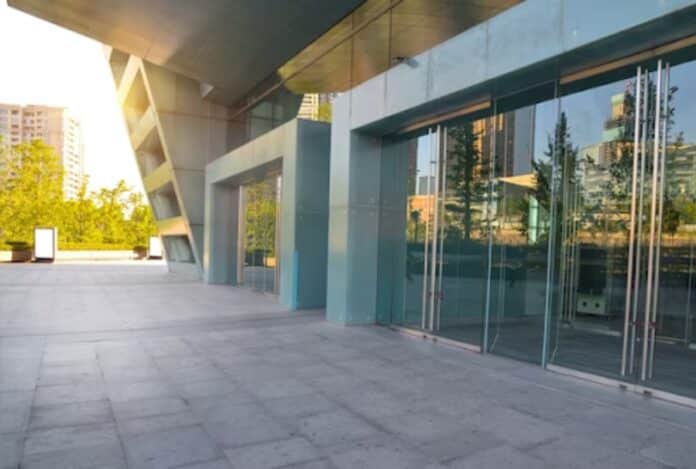
In the realm of architectural design, the integration of technology into structural elements has become increasingly prevalent.
Office spaces, in particular, are undergoing significant transformation. One of the most notable developments in this area is the incorporation of smart technologies into partition walls for offices. This article explores the innovative ways in which technology is being integrated into glass partition wall designs to create more intelligent, efficient, and engaging environments.
Tech-Infused Environments: Enhancing Glass Partition Walls with Integrated Smart Technologies
In the contemporary market, the demand for smart office spaces is soaring. The integration of smart technologies into glass partition walls is revolutionizing office design, transforming traditional spaces into dynamic, tech-infused environments. This integration is not just about aesthetics or modernizing the look of an office, but it’s also about enhancing functionality, boosting productivity, and improving the overall user experience.
The advent of smart glass technologies, such as adaptive glazing, has made it possible to control the level of light and heat that passes through glass partition walls. This not only enhances the comfort of occupants but also reduces the need for artificial lighting and air conditioning, leading to considerable energy savings. Moreover, the transparent nature of glass partition walls facilitates the flow of natural light throughout office spaces, contributing to a more inviting and productive environment.
Incorporating smart technologies into partition walls for office also allows for seamless connectivity and improved communication. The integration of digital display screens and interactive whiteboards into glass partition walls, for instance, enables real-time information sharing and collaboration, fostering a more connected and efficient workspace.
Connectivity Solutions: The Role of Glass Partition Walls in Facilitating Technological Interaction in Spaces
The role of glass partition walls in office spaces extends beyond simply dividing rooms or creating a modern aesthetic. They are now being used as platforms for facilitating technological interaction, offering advanced connectivity solutions that help to streamline operations and improve business productivity.
One such example of this is the integration of smart glass panels that can switch from transparent to opaque with the simple touch of a button or through a mobile app. This innovative feature allows for privacy on demand, providing an effective solution for meeting rooms or individual workstations where confidentiality is required.
In addition to privacy control, glass partition walls can also be equipped with touch-screen interfaces, turning them into interactive surfaces. These interfaces can be used to control various aspects of the office environment, such as lighting, temperature, and even multimedia presentations. They can also be synced with personal devices, allowing employees to manage their workspace according to their individual needs and preferences.
Another revolutionary trend in the realm of smart partition walls for office is the incorporation of wireless charging technology into glass surfaces. By embedding inductive charging coils into the glass, office partition walls can double as charging stations for mobile devices, eliminating the need for messy cables and enhancing workspace efficiency.
Smart Lighting Integration: Enhancing Ambiance and Efficiency through Technology in Glass Partition Wall Designs
Lighting plays a pivotal role in defining the ambiance of a space and influencing the productivity and well-being of its occupants. Recognizing this, designers are now integrating smart lighting technology into glass partition wall designs, creating environments that are not only visually appealing but also energy-efficient and conducive to productivity.
Smart lighting systems can be integrated into glass partition walls in various ways. Light-emitting diodes (LEDs), for instance, can be embedded into the glass to create dynamic light patterns, enhancing the aesthetic appeal of the office environment. These LEDs can be programmed to change colors and intensity according to the time of day or the mood of the occupants, adding a dynamic element to the workspace.
Apart from LEDs, glass partition walls can also be equipped with smart windows that are capable of self-regulating their light transmission properties in response to external conditions. This means that they can automatically darken or lighten to maintain optimal light levels in the office, regardless of the intensity of sunlight. This not only ensures a consistent and comfortable lighting environment but also reduces dependence on artificial lighting, leading to substantial energy savings.
Interactive Glass Surfaces: The Future of User Engagement through Technology-Infused Glass Partition Walls
The future of office design lies in creating interactive environments that engage users and facilitate collaboration. With the advent of advanced technologies, glass partition walls are evolving from passive barriers to interactive surfaces, heralding a new era of user engagement in office spaces.
One of the most exciting developments in this area is the rise of smart glass walls that double as digital displays. These walls can be used to display a wide range of content, from company news and updates to real-time data analytics, fostering a more informed and connected workforce.
Beyond digital displays, glass partition walls can also be equipped with touch-sensitive surfaces that allow users to interact with the displayed content. This interactive feature transforms glass walls into giant tablets, enabling brainstorming sessions, presentations, and group collaborations to happen in a more engaging and efficient manner.
Technological advancements are also paving the way for the integration of augmented reality (AR) and virtual reality (VR) technologies into glass partition walls. This could enable 3D visualizations and immersive experiences in office spaces, opening up a plethora of opportunities for innovation and creativity.
In conclusion, the integration of technology into glass partition wall designs is revolutionizing the concept of smart spaces, transforming office environments into dynamic, efficient, and engaging arenas. As technology continues to evolve, one can expect to see even more innovative applications of smart technologies in glass partition wall designs, further redefining the office of the future.








